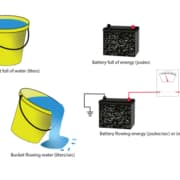Electricity on Your Charter Boat
It’s a given, we can’t live without electricity. At home, we have all the conveniences and all the chargers we need. But what about on a boat on a sailing vacation? What can I charge and what voltage is available?
Here is a complete rundown of how to stay charged and connected on a charter boat on a sailing vacation. This article is an excerpt from the NauticEd Bareboat Charter course. If you find this valuable, consider taking the course and adding it to your sailing resume.
If you just want the quick info of what we recommend you should take on a charter, then jump to the bottom of this article.
Voltages and Plugs
At home we plug into the wall at either 110 volts AC in North and some of South America or 220 volts AC elsewhere (except Japan is 100 volts AC). Some of the Caribbean is 220 V and some is 110v. To make matters more confusing there are 15 different types of electric wall plugs worldwide.
Here is a list of countries showing which voltage they operate on and which plug type they use.
Here is a listing and drawing of all the world’s plug types
Fortunately, it’s not as bad as you might think. Nowadays, all our handheld devices worldwide charge using USB (Universal Serial Bus) which is world standardized at 5V DC. This is the case for USB 1, 2, 3 and 4. Even better, the little block (transformer) that plugs into the wall with USB outlets is smart and can take any input AC voltage no matter the country. That is, it can intelligently convert either the 110 V AC or 220V AC to the USB 5 volt DC. Similarly, your laptop power supply (the inline-block (transformer) in the middle of the cord) is smart. It will convert any input AC voltage to the DC power (typically 15 V) required to charge and power your laptop. The only issue is that you need to have an adapter plug to match the pin arrangements.
On the boat – at the dock
At the dock, it’s like home. You have an unlimited supply of electricity coming from the dock mounted power supply pedestal via the big yellow or orange cables connected to the stern of the boat. The electricity is distributed to AC outlets all over the boat, to the air conditioning unit, battery chargers. In Europe, the voltage supplied from the pedestal is going to be 220V AC. In the Caribbean, USA, and various other parts of the world it could be both, just 220 V AC, or just 110 V AC. You have to be careful a little because you must match the dock pedestal voltage to the voltage your boat is set up for. For example, you don’t want to plug 220 V power supply into your boat that is set up for 110V or vice versa. However, since the dock pedestal plugs and your boat receptacle plug are specifically for either 220V or 110 V, it is unlikely you will be able to make that mistake. The important thing is to know what voltage you have on your boat and plan your devices around that.
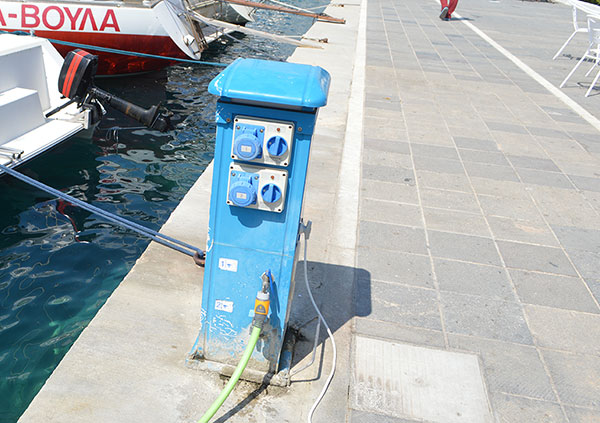
Electricity (and water) pedestal on the dock
The above is a picture we took in Poros Greece of a typical pedestal. In Europe, these pedestals take an 220 V AC IEC 309 type plug for higher amperages.
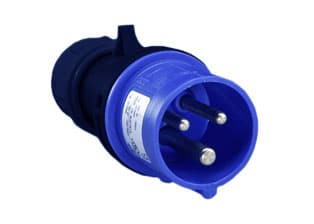
IEC 309 20 amp plug 220V AC
In the USA the (awful and poorly designed) twist in L5-20 is used to plug into the pedestal for 110 V AC. We say awful because this plug is responsible for burning boats to the water line. It was designed in the 1930’s for high current (20 amps) but the L5-20 was never intended to operate in a marine environment. Whenever using any of these plugs, check the plug and receptacle for burn marks. Here is an article we wrote on a smarter alternative that is used on the boat side plug – but I digress.
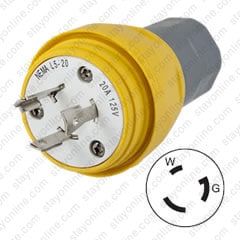
NEMA L5-20
Many boats are made in Europe and so it is typical that for a European made boat, the AC outlets inside the boat will be the Euro two round prong style (Type F) pumping out 220V AC. If you are European, no problem; just plug right in. That is if the outlet is powered from shore, the generator, or an inverter. If you are from elsewhere you will need an adapter like this one shown. An adapter is a plug that changes nothing except the pin arrangement from one type of receptacle plug to the another. Either American to Euro or Euro to American (see below for an adapter plug). They do not change the voltage. Hair dryers and the like will burn out in an instant – permanently is the voltage is a mismatch. Your laptop and USB plugs will not. They have smart electronics to accept any incoming voltage.
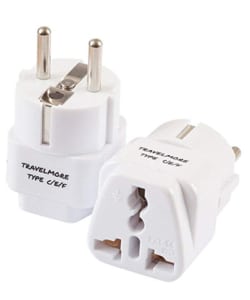
Euro Adapter to American (and others – multi-dextrous)
Some European made boats are fitted with American style outlets. If this is the case and your device plugs are not American, then you will need an American to Euro adapter.
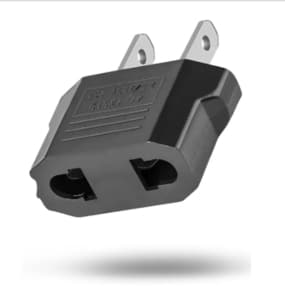
American Type Adapter to Euro
Adapters are readily available on Amazon. But don’t wait until you are in the airport to get one because the prices are triple.
If you are chartering a boat, you more than likely will not know the voltage or the plug type on the boat’s AC supply ahead of time. But fortunately, it will be either of 110 V AC with American plugs (Type A or B) or 220 V AC with European plugs (type F). We say “Fortunately”, because mostly you are using USB charger devices and laptops which don’t care about input voltage, all you really need is an adapter plug. For this sake, you should always just keep some adapters in your charter kit bag. Even if you know the boat because sometimes at the last minute you might be assigned to a different boat.
Again, be aware that an adapter does NOT change the voltage. So if you have a device that is not smart (does not accept any voltage) then using the wrong voltage will kill that device despite using an adapter. A common example of this is a hair dryer. You must use the proper voltage for a hairdryer. You can not simply plug it in through an adapter. Some hair dryers have a switch on them to change the setting for the input voltage. Many don’t.
In Summary, know what voltage is coming out of the wall on the boat before plugging in. A Type F Euro receptacle is 220V AC and a Type A or Type B USA is 110V AC.
On the boat at sea
When away from the dock, you are relying on electricity that is generated on the boat by various means. Unless you have an electric generator in the boat (see below) all the electricity available to you for use is from the energy that has been stored in the battery banks and then is converted to a convenient voltage on demand.
Typically there are two battery banks to store the electrical energy: the “engine battery bank” is used to store enough energy to restart the engine, and the “house battery bank” is used to store enough energy for the operations of the boat such as navigation equipment, fridge, water pump, lights, entertainment systems, and 12v charging outlets. The banks are electrically kept separate (isolated) for good reason; you don’t want to not be able to start the engines in the morning just because you ran the stereo all night. Since the house bank is constantly being drained, they must be charged as much and as often as possible to maintain available energy on your boat.
Inverter:
An inverter does not create or generate electricity. It merely changes (inverts) DC electricity from the battery bank into 110/220 V AC electricity. Big inverters can change 12V DC to high amperage 110/220V AC. About the only use for these big inverters on a boat is to run the microwave and perhaps a coffee maker or hairdryer. If a big inverter is installed on a boat it will typically power one separate AC outlet near the electric panel and be permanently wired to the microwave. The AC outlet will likely be labeled “Inverter outlet”.
Small inverters you bring from home will change 12v DC from the battery bank to 110/220V AC but only for small current devices such as a laptop or for USB plugs. The 12 DC plugs to power these small inverters are typically the old cigarette style receptacles near the electric panel. They will probably not be in the cabins as smoking in a cabin is highly discouraged.
Alternator:
Attached to the engine(s) on a boat is an alternator. Alternators typically generate about 14v DC which charges the 12V DC battery banks.
Generator:
Many times on a boat there is a generator, which is a fairly big separate engine running also on diesel. The generator’s sole purpose is to create (generate) electricity from the diesel. About the only use for a generator on a boat is for air conditioning and the microwave although it will also create 110/220V AC to power and distribute to outlets all over the boat while the generator is running. The generator will also charge the battery banks. When chartering a boat, you should find out if the boat has a generator. If it does not then anytime you are not connected to a shoreside cable at the dock you’re unlikely to be able to run any high current 110/220 V AC devices on the boat like microwaves and hairdryers. Additionally, you will typically only run the generator when required usually at night for air conditioning and for the coffee machine in the morning. It should not be run while under sail in a monohull because the heel of the boat hinders the ability of the engine oil to lubricate the internal workings of the engine. Ultimately, it is pretty embarrassing to start up the generator to make a cup of coffee.
Solar panel banks and wind generators
These produce electricity at 14 Volts DC and pump that energy into the battery banks to be stored.
Summary of Available Electricity
- There is an ample supply of 12 V DC for USB devices and laptops
- For low current draw devices requiring 110 V or 220 V AC, you will need to bring a small inverter (see below) to convert the 12 V DC to 110 V or 220 V AC.
- If there is a generator, you will have unlimited 110 V or 220 V AC for high current devices while the generator is running
- If there is a large inverter, you will have 110 V or 220 V AC for high current devices including the Microwave.
- To keep the batteries charged you need, constant solar or wind, a generator, an Integrel system, or run the propulsion engine 2 hours per day.
Entertainment
Most late model boats have a Bluetooth-enabled stereo system. Some don’t. Thus it is a good idea to keep an audio cable with two 3.5 mm male jacks in your charter kit.
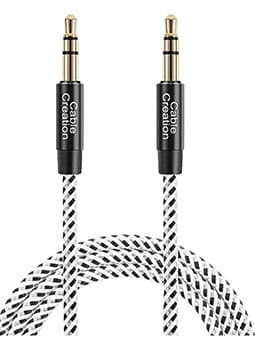
3.5mm audio jack
Terminology
- Adapter – changes the pin configuration from one country-style plug to another.
- Transformer – changes AC voltage to DC – or can one DC voltage to different DC Voltage or can change one AC voltage to another AC voltage
- Inverter – changes DC voltage to AC voltage
- AC – Alternating Current – usually high voltage (100 and above) and dangerous. Electricity from the wall plugs
- DC – Direct Current – usually lower voltage – eg USB is 5V DC
Plugs on a boat
Depending on your crew on your boat, your electrical requirements are going to be mostly laptops, cameras, mobile phones and tablets. Typically, each person will need 2 USB ports. Thus to charge everyone’s devices you should plan on lots of USB outlets. Many newer boats have USB outlets in the electric panel, near the chart table and throughout the boat and even in the cabins. However, you can guarantee there are not enough USB outlets for all the devices for you and your crew. Therefore, we recommend bringing a USB splitter with 4 outlets or eight (or sixteen).
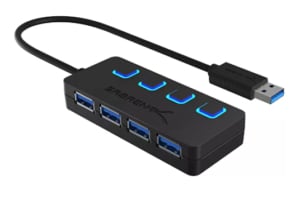
USB splitter with 4 outlets
In one or two places around the boat, there may still be the old cigarette lighter style outlets. These are 12 volt DC outlets. Typically you will plug in a small inverter to these to allow for a 110 or 220 V DC low power outlet. You will need these outlets to charge laptops and some camera batteries.
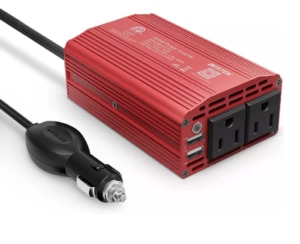
12 V DC to 110V AC Inverter with 2 USB ports
To provide more AC outlets you might take one of these 3 or 4-way AC splitters.
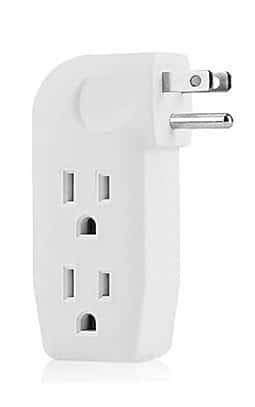
4-way Plug Splitter
You can also plug in a Cigarette style 12 V DC to USB 5V DC plug transformer.
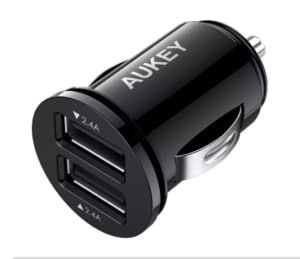
Cigarette style plug To USB
You might also think about a 2 socket cigarette plug splitter. There might be only one receptacle plug on the boat.
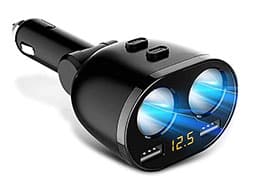
2 socket Cigarette Plug Splitter
What to permanently have in your Charter Kit Bag
- Euro to American adapter OR an American to Euro adapter depending on your own device plugs
- A small inverter 12 V DC to either 110V AC or 220V AC with several USB outlets
- A 110 V (or 220 V) 3-way/4-way outlet plug
- Cigarette style plug with 2 USB outlets
- Maybe a cigarette style splitter
- USB Splitter 4 or more outlets
- 3.5 mm audio jack male to male.
Did you know?
(1) In order to charter in the Mediterranean or the Seychelles, you need an accepted Sailing License. Examples of acceptable licenses are:
- The NauticEd SLC
- The United Nations ICC issued by the RYA (Royal Yachting Association out of the UK)
- RYA Day Skipper or above from the RYA
All yacht charter companies in the Mediterranean and Seychelles recognize and accept the SLC. The SLC is the simplest to gain if you are in North America. NauticEd can also facilitate the ICC through our relationship with the RYA. Here is a comparison of the SLC and ICC licenses for your information. Note that the IPC is NOT the ICC (altho it is portrayed as such by certain associations).
(2) NauticEd are Yacht Charter Agents. We don’t charge you a fee; you get the same price as if going direct but we almost always are able to save you money because or our back-end travel agent search ability. We have access to over 5000 boats in 55 destinations. Plus, chances are, we have been to your destination of choice so can give you tips along the way. Go to www.nauticed.org/sailing-vacations now.
- Getting a Sailing Qualification while on a Sailing Vacation - April 24, 2024
- RYA Day Skipper with NauticEd - April 1, 2024
- NauticEd uses the SailTies GPS Tracking App - March 29, 2024

